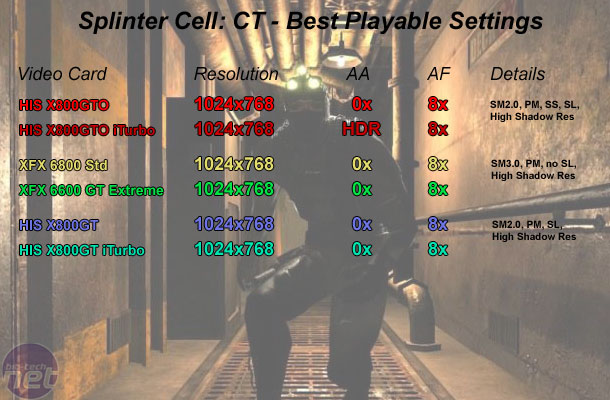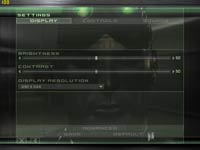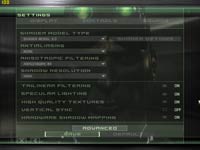Splinter Cell: Chaos Theory
Publisher: UbisoftWe used the full version of Splinter Cell: Chaos Theory patched to version 1.04. It features a new game engine that has been created around a heavily modified Unreal Engine 2 - the game used to only have two shader profiles: Shader Model 1.1 and Shader Model 3.0. All of ATI's current video cards default to Shader Model 1.1, and only the GeForce 6 series is capable of using the Shader Model 3.0 path.
However, the introduction of patch 1.04 bought a Shader Model 2.0 profile for ATI's current generation video cards. You can read more about the Shader Model 2.0 path here.
We configured both Anti-Aliasing and Anisotropic Filtering from within the game, and thus the driver control panel was left set to "Application Controlled".
Below is a table of the best-playable settings that we found best for each video card configuration. In this title, we found that 20 to 25 frames per second minimum and a target of 45 frames per second (or higher) for the average frame rate delivered a smooth and fluid gaming experience across the rest of the game. The title is quite slow paced, so we can afford to lower the threshold on what we determine to be playable.
Key:
- SM1.1 - Shader Model 1.1 path;
- SM2.0 - Shader Model 2.0 path;
- SM3.0 - Shader Model 3.0 path;
- SL - Specular Lighting;
- PM - Parallax Mapping;
- SS - Soft Shadows;
- HDR - High Dynamic Range Lighting;
- TM - Tone Mapping

When we enabled iTurbo mode, we found that we were able to turn HDR on too, with all other details remaining the same. We lost around one frame per second on the average frame rate while the minimum frame rate remained the same.
We also found that the XFX 6800 Std was only marginally faster than the XFX 6600 GT Extreme Gamer Edition, such that we were not able to increase the image quality when switching video cards. We believe this is because the game is both shader heavy and also memory bandwidth dependant. The XFX 6600 GT Extreme Gamer has higher pixel shader throughput, despite having only 8 pixel pipelines in comparison to the 6800 Std's 12 fragments, thanks to its high clock speed. On the other hand the XFX 6800 Std has a higher memory bandwidth along with more vertex shader throughput. Thus, we were not surprised that the 6800 Std could only match the XFX 6600 GT Extreme Gamer in this title.
We found that 1024x768 0xAA 8xAF using the Shader Model 3.0 path with parallax mapping and high shadows detail delivered the smoothest possible experience. There was no difference in the minimum frame rate, but the average frame rate was a mere three frames per second in favour of the 6800 Std - the XFX 6600 GT managed just under 45 frames per second average.
With the HIS X800GT, we found that the best playable settings for the card when operating at its default frequencies were the same as when the video card was overclocked. We saw a slight improvement in the smoothness of game play, but on the whole the differences between the way the two different frequencies handled the game was fairly small. We found that 1024x768 0xAA 8xAF using the Shader Model 2.0 path with high shadows, parallax mapping and specular lighting delivered the smoothest possible game play on this video card whether operating at its default clocks or at the enhanced iTurbo speeds.

MSI MPG Velox 100R Chassis Review
October 14 2021 | 15:04








Want to comment? Please log in.